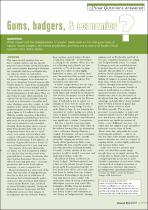JavaScript is disabled for your browser. Some features of this site may not work without it.
- ResearchSpace
- →
- Research Publications/Outputs
- →
- Journal Articles
- →
- View Item
| dc.contributor.author |
Van Wilgen, BW

|
|
| dc.date.accessioned | 2009-11-23T08:36:02Z | |
| dc.date.available | 2009-11-23T08:36:02Z | |
| dc.date.issued | 2007 | |
| dc.identifier.citation | Van Wilgen, BW. 2007. Gums, badgers, and economics. Quest, vol. 3(4), pp 41 | en |
| dc.identifier.issn | 1729-830X | |
| dc.identifier.uri | http://hdl.handle.net/10204/3770 | |
| dc.description | Copyright: 2007 Academy of Science of South Africa | en |
| dc.description.abstract | Gums trees (in the genus Eucalyptus, from Australia) are not set to ‘disappear’ (even if some people wanted them to). Gums form an important component of the forest industry and, at last count, they covered over 540 000 ha in formal plantations in South Africa. They are also found in many other plantations not captured by the forest industry’s statistics, as well as in thousands of woodlots and other plantings across the country. The impacts of invasive alien plants on ‘nature’ are well documented. Suffice it to say that they are the second most powerful threat to native biodiversity after direct habitat destruction. However, the effect of removing gum trees – on honey production and on the South African economy – is also a complex one. Honey production is a minor part of the story. The true value of managed honey bees lies in their use as pollinators of deciduous fruit orchards (mainly apples and pears). The deciduous fruit industry, centred in the Western Cape, is valued at around R3 billion annually | en |
| dc.language.iso | en | en |
| dc.publisher | Academy of Science of South Africa | en |
| dc.subject | Invasive plants | en |
| dc.subject | Honey production | en |
| dc.subject | Gums | en |
| dc.subject | Economic impact | en |
| dc.subject | Honey badgers | en |
| dc.subject | Gums trees | en |
| dc.subject | Eucalyptus | en |
| dc.subject | Honey bees | en |
| dc.title | Gums, badgers, and economics | en |
| dc.type | Article | en |
| dc.identifier.apacitation | Van Wilgen, B. (2007). Gums, badgers, and economics. http://hdl.handle.net/10204/3770 | en_ZA |
| dc.identifier.chicagocitation | Van Wilgen, BW "Gums, badgers, and economics." (2007) http://hdl.handle.net/10204/3770 | en_ZA |
| dc.identifier.vancouvercitation | Van Wilgen B. Gums, badgers, and economics. 2007; http://hdl.handle.net/10204/3770. | en_ZA |
| dc.identifier.ris | TY - Article AU - Van Wilgen, BW AB - Gums trees (in the genus Eucalyptus, from Australia) are not set to ‘disappear’ (even if some people wanted them to). Gums form an important component of the forest industry and, at last count, they covered over 540 000 ha in formal plantations in South Africa. They are also found in many other plantations not captured by the forest industry’s statistics, as well as in thousands of woodlots and other plantings across the country. The impacts of invasive alien plants on ‘nature’ are well documented. Suffice it to say that they are the second most powerful threat to native biodiversity after direct habitat destruction. However, the effect of removing gum trees – on honey production and on the South African economy – is also a complex one. Honey production is a minor part of the story. The true value of managed honey bees lies in their use as pollinators of deciduous fruit orchards (mainly apples and pears). The deciduous fruit industry, centred in the Western Cape, is valued at around R3 billion annually DA - 2007 DB - ResearchSpace DP - CSIR KW - Invasive plants KW - Honey production KW - Gums KW - Economic impact KW - Honey badgers KW - Gums trees KW - Eucalyptus KW - Honey bees LK - https://researchspace.csir.co.za PY - 2007 SM - 1729-830X T1 - Gums, badgers, and economics TI - Gums, badgers, and economics UR - http://hdl.handle.net/10204/3770 ER - | en_ZA |






